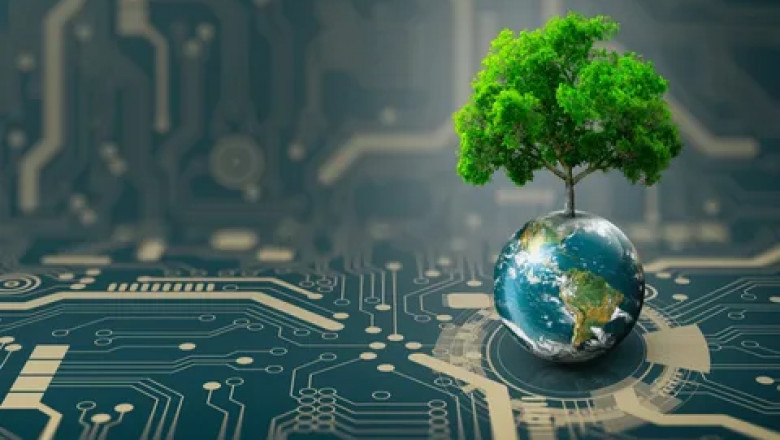views
In the face of climate change, environmental degradation, and depleting natural resources, green technology and sustainable innovation have emerged as crucial pillars for building a better, more sustainable future. The global shift towards sustainability is no longer just an aspiration but an urgent necessity. As populations grow and industries expand, it has become clear that our current modes of production, consumption, and energy use are unsustainable. Green technology is not just a response to environmental issues; it is a proactive, innovative approach that harnesses new technologies to meet the needs of today while ensuring that future generations can thrive.
The Concept of Green Technology
Green technology, often referred to as "clean tech" or "environmental technology," is the development and application of products, services, and processes that use renewable resources, reduce energy consumption, minimize waste, and minimize environmental impact. Unlike traditional technologies, which often prioritize cost-effectiveness and speed over ecological responsibility, green technology emphasizes sustainability. It aims to create solutions that are beneficial for both the economy and the environment. From renewable energy sources like solar and wind to sustainable agriculture and eco-friendly construction materials, green technology is broad, encompassing a wide range of sectors.
One of the most well-known examples of green technology is solar power. Solar panels convert sunlight into electricity, offering a renewable and virtually limitless energy source. Wind turbines, another prime example, harness the wind's energy to generate power without emitting harmful pollutants. Green tech innovations in energy production are vital in the transition away from fossil fuels, which are major contributors to climate change and air pollution.
The Role of Sustainable Innovation
Sustainable innovation goes hand in hand with green technology. It involves the development of new ideas, processes, and products that provide solutions to environmental challenges while promoting social and economic development. Sustainable innovation is not confined to energy solutions but extends to every industry, from transportation and manufacturing to agriculture and waste management.
One of the key drivers of sustainable innovation is the circular economy model, which focuses on reducing waste, reusing resources, and recycling materials to create a more sustainable production and consumption system. In a traditional linear economy, products are made, used, and then disposed of, often contributing to environmental degradation. A circular economy, on the other hand, seeks to close the loop by designing products for reuse, repair, and recycling, reducing the need for virgin materials and decreasing the waste that ends up in landfills.
The concept of sustainable innovation also includes advancements in green building practices. Eco-friendly construction materials, energy-efficient design, and the use of renewable energy sources for heating, cooling, and lighting have transformed the construction industry. Buildings that are designed with sustainability in mind can significantly reduce carbon footprints and lower energy costs while providing a healthier living environment for their occupants.
Green Technology in Action
Several industries are already benefiting from green technology and sustainable innovation, with remarkable successes paving the way for broader adoption. The automotive sector is one such area where sustainable innovation is thriving. Electric vehicles (EVs) are increasingly seen as the future of transportation, offering a zero-emissions alternative to traditional gasoline-powered cars. Advances in battery technology have made EVs more affordable and efficient, with many car manufacturers now shifting their focus to electric models.
In agriculture, sustainable farming practices are being embraced to reduce the environmental impact of food production. Technologies such as precision farming use data and sensors to optimize the use of water, fertilizers, and pesticides, minimizing waste and improving yields. Vertical farming, where crops are grown indoors in stacked layers, is another innovative approach that reduces the need for vast expanses of arable land, thus conserving natural habitats and reducing transportation emissions.
Waste management is another area where green technology has made a significant impact. Advances in recycling technologies have made it easier to separate and repurpose materials, diverting waste from landfills and turning it into valuable resources. The rise of waste-to-energy technologies, which convert waste into electricity or heat, offers an alternative to traditional landfilling, reducing both waste and reliance on fossil fuels.
The Future of Green Technology and Sustainable Innovation
The future of green technology and sustainable innovation is bright, but it also requires collaboration, investment, and political will. Governments around the world are increasingly implementing policies that incentivize green technologies and penalize environmentally harmful practices. Policies such as carbon pricing, subsidies for renewable energy, and regulations for waste management and pollution control are essential in accelerating the adoption of green technologies.
Private companies also have a critical role to play. By investing in research and development, companies can drive the next wave of innovation. Furthermore, businesses must adopt sustainability as a core principle, not just as a marketing tool. Consumer demand for sustainable products and services is on the rise, and businesses that embrace sustainability will not only contribute to a better world but also position themselves for long-term success in an increasingly eco-conscious market.
Education and awareness are equally important in promoting green technology. Empowering individuals with knowledge about sustainability and green technology can lead to more responsible consumer behavior and greater support for environmental policies. From using energy-efficient appliances at home to supporting sustainable brands, every action counts toward building a greener future.
Conclusion
Green technology and sustainable innovation are key to addressing the pressing environmental challenges of our time. By embracing these innovations, we can create a world where economic growth and environmental preservation go hand in hand. As technology continues to evolve, it is essential that we continue to foster creativity, collaboration, and commitment to sustainability. In doing so, we can build a better future for ourselves and generations to come, where both people and the planet can flourish.














Comments
0 comment